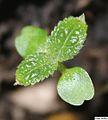Girardinia diversifolia, commonly known as the Himalayan nettle[2] or Nilghiri nettle,[3] is a plant species native to Nepal and in the Himalayan parts of India such as Uttarakhand, Himachal Pradesh and Jammu and Kashmir and in vast parts of China.[4] It grows naturally at elevations between 1,200 to 3,000 metres (3,900 to 9,800 feet). It is a shade tolerant, tall, stout and erect herb growing up to 3m height with perennial rootstock. The plant grows as a clump, and each clump has many stems. The stem contains bast fiber of unique quality which is strong, smooth and light.[5]
| Girardinia diversifolia | |
|---|---|
 | |
| Scientific classification | |
| Kingdom: | Plantae |
| Clade: | Tracheophytes |
| Clade: | Angiosperms |
| Clade: | Eudicots |
| Clade: | Rosids |
| Order: | Rosales |
| Family: | Urticaceae |
| Genus: | Girardinia |
| Species: | G. diversifolia |
| Binomial name | |
| Girardinia diversifolia (Link) Friis | |
| Synonyms[1] | |
| |
Description
It is a 1.5 to 3 metres tall[6] perennial herbaceous shrub that grows without cultivation all over Nepal.[7] It most frequently occurs in the hilly and mountainous regions at altitudes up to 3000 m.[8]
Uses
Traditional users of Allo are ethnic groups from across Nepal, including the Kulung, Gurung, Magar, Rai and Tamang people.[9] Allo products are culturally important to both the Gurung[9] and the Rai.[8] It is also sold for commercial and non-religious purposes.[7] Non-fibre uses of the plant range from fodder and fuel wood,[8] to use as a live fence and in traditional medicines.[9] Allo fibre is very flexible and has high tenacity,[10] allowing it to be used in a multitude of applications ranging from clothing and bags to floor mats and rope.[9][11][12] Fibres made from allo are fully biodegradable.[10]
Gallery
- Inflorescence
- Fruits
- Seedling
- Seeds
References








